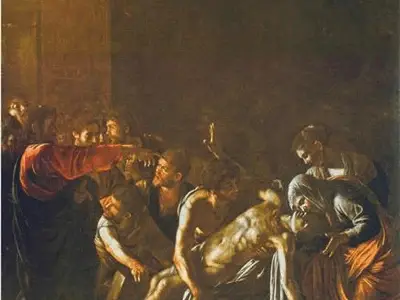Title of Artwork: “Resurrection of Lazarus”

Artwork by Caravaggio
Year Created 1608 – 1609
Summary of Resurrection of Lazarus
The Italian painter Caravaggio completed his The Raising of Lazarus around 1609, and it is currently on display at the Museo Regionale in Messina (1571–1610).
The artist Caravaggio and his artist companion Mario Minniti escaped to Sicily in August 1608 after Caravaggio was imprisoned on Malta for an unspecified offence.
As a result of Minniti’s advocacy, he was awarded several significant contracts, including this one for the Padri Crociferi church in Messina, which was donated on June 10, 1609, by the wealthy Genoese businessman Giovanni Battista de’ Lazzari.
The payment was a whopping one thousand scudi, or roughly twice as much as Caravaggio had ever made before.
All About Resurrection of Lazarus
Caravaggio was commissioned to paint an altarpiece for Giovanni Battista de’ Lazzari at the church of the Padri Crociferi. The subject matter was Lazarus, the brother of Martha and Mary. His sickness, death, burial, and subsequent resurrection are all detailed in the Gospel of John. In this picture, as in others from this time in Caravaggio’s career, the frieze of human players is dwarfed by the white walls.
In contrast to the tightly focused individual dramas of his early and middle eras, the interaction of the relief of characters engaged in collective struggle and emotion, with a huge emptiness above, is strikingly different.
Light plays a significant role in the scene, highlighting key elements such as Lazarus’s hands (one relaxed and open to receive, the other outstretched towards Christ) and the amazed expressions of the onlookers, as is typical of Caravaggio’s work.
It is “possibly mythical, but not beyond the boundaries of probability” that Caravaggio had a recently buried cadaver resurrected for this work (John Gash, see below).
Caravaggio is reported to have relied on his memories as well as an engraving by Giulio Romano for the composition, and his depiction of Jesus is a mirror reflection of the Christ who invited Saint Matthew to follow him in The Calling of Saint Matthew.
It’s probable that some of the passages in the painting are not even the artist’s original handiwork, given the state of the picture and the number of restorations it’s undergone.
Francesco Susinno claims that Caravaggio created a first version, but after hearing criticism, he cut it apart with a razor. After that, he would have completed the current version in record time, but it’s likely that this is an exaggeration.
Information Citations:
En.wikipedia.org, https://en.wikipedia.org/.























